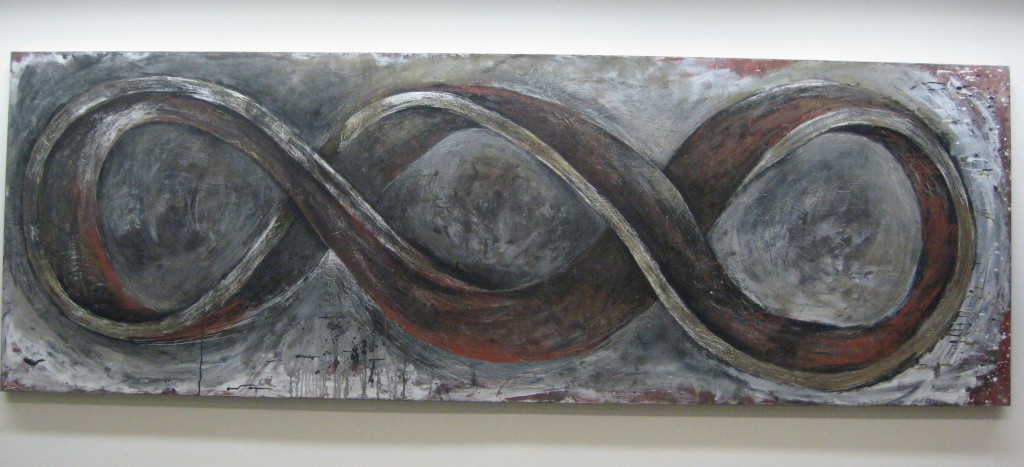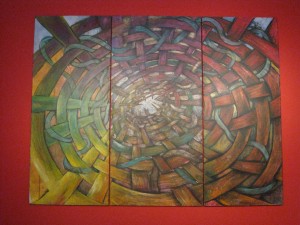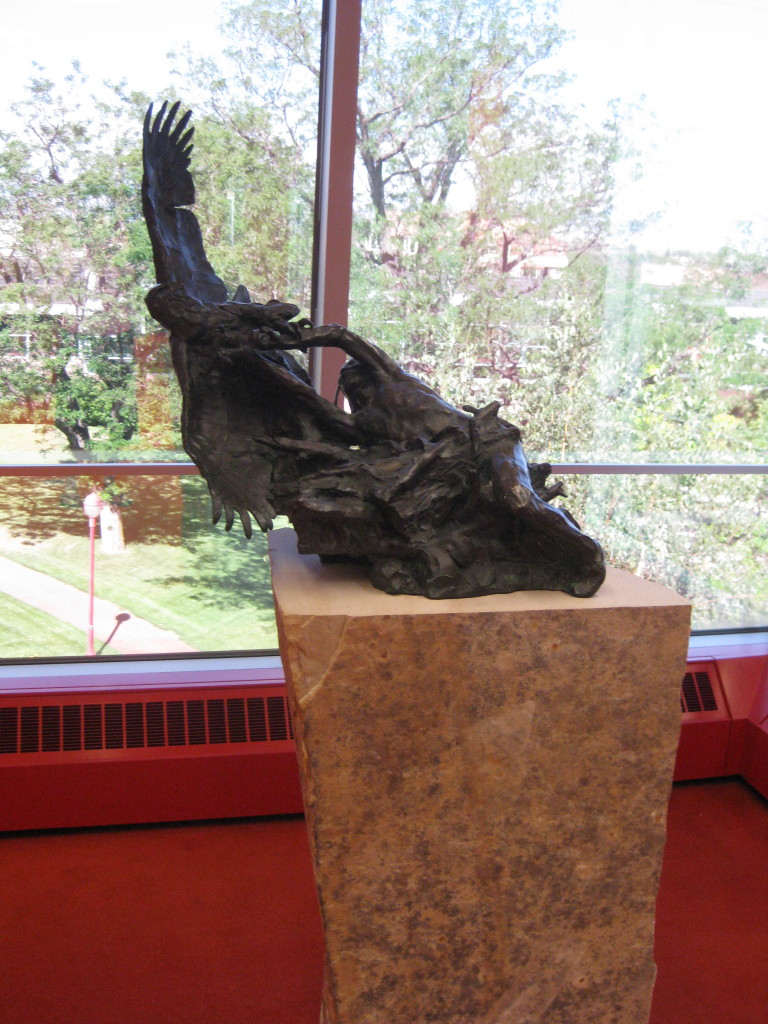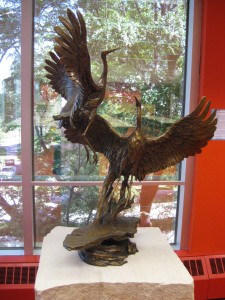Anderson Academic Commons

Deborah Howard, Triple Möbius, 1999, acrylics and ink on paper
Location: Anderson Academic Commons, Research Center
Artist Statement:
“In mathematics, the Möbius is the symbol for infinity. It has two loops and resembles the number eight lying horizontally. A three-dimensional Möbius is a twisted ribbon with a surface that flows continuously from the inside to the outside. In Triple Möbius there are three loops instead of two. If you start anywhere on the loop you will travel to the outside and back to the inside continuously.
“The painting was inspired by a childhood memory of being with my father at a science museum and seeing a large model of a möbius ribbon. The model had a toy train that traveled on a track from the inside to the outside continuously—to a child it seemed magical. After completing this painting, I was amazed when told by a math professor that the Möbius I created for personal reasons was also ‘pure math’ because it had three working loops instead of the usual two.
“I feel the möbius resembles the process of doing research in a library where one can discover a path that will lead from one idea to another on a journey that is cyclical and unending.”

Deborah Howard, Arachne, 1999, acrylics and ink on paper
Location: Anderson Academic Commons, Stairwell
Artist Statement:
“Upon completing this painting, I realized it looked like a spider web and titled it Arachne from Greek mythology. Arachne was a mortal who created weavings more beautiful than the goddess Athena, who jealously turned Arachne into a spider.
“The painting also resembles a labyrinth, which has been used since ancient times for meditation. Its cyclical design leads participants into the center and then back to the entrance to begin again.
“I feel it is appropriate that this painting has found a home in the library. Like a labyrinth, a library is a place where one can still wander and discover unexpected ideas that might lead to other ideas and new realizations.”

George Carlson, Eagle Catcher, 1973, bronze
Location: Anderson Academic Commons, Second Floor, Northwest Corner
As a sculptor of western subject matter, George Carlson is best known for his representations of animals in bronze. He studied art at the American Academy of Art and at the Art Institute of Chicago, continuing with anthropology studies at the University of Arizona. His time in the Southwest inspired an interest in regional Native American culture and imagery.
Eagles appear often in Carlson’s sculpture from the late 1960s onward. He bases these complex compositions on careful studies of the birds in the wild. The eagle’s graceful flight and its role in Native American traditions are both represented in this work. The prize-winning Eagle Catcher is often cited as one of the artist’s most significant early bronzes.

Dee Clements, Birds of Happiness, 1995 (recast 2009), bronze, 4/36, Gift in memory of Stuart B. James, Professor of English 1957-86 Professor emeritus from 1986
Location: Anderson Academic Commons, Second Floor, Northwest Corner
Dedicated on Oct. 30, 2009, this sculpture—titled Birds of Happiness—was installed in Penrose Library in memory of Stuart James, a DU English professor from 1957–86. Jean James, Stuart’s widow, and their daughter, Barbara James, commissioned the sculpture in 1995 from Loveland, Colo., based sculptor Dee Clements; it previously was located outdoors near Sturm Hall. Jean James, retired librarian and DU alumna, was at first unsure about how to select a sculpture in memory of her husband Stuart. He was an avid birder and nature lover, so Jean and her daughter Barbara decided to choose a nature-inspired sculpture. The idea for the piece arose from trips that Jean and Stuart had taken to whooping crane breeding grounds at Bosque del Apache, New Mexico and Kearney, Nebraska. Cranes are also known to mate for life, which further influenced Jean’s choice. In early 1995, she visited a bronze foundry in Loveland, Colorado, where she met Dee Clements. He showed her an incomplete wax model of the cranes. Though it was still in parts, she knew imediately that it was exactly right.
The work of Loveland sculptor Dee Clements is often inspired by his own life experiences. His tour of duty as a helicopter pilot in Korea instilled in him a fascination with the “beauty of the Orient.” The red-crown crane appears in Asian art and literature as a symbol for eternal life and longevity. He holds an MA in sculpture from the University of Northern Colorado, Greeley, and is a member of the National Sculptors’ Guild. He has completed numerous commissions for public sculpture in the U.S. and abroad.
Click HERE to return to the Campus Art Highlights page
View Living Memory DU in a larger map
